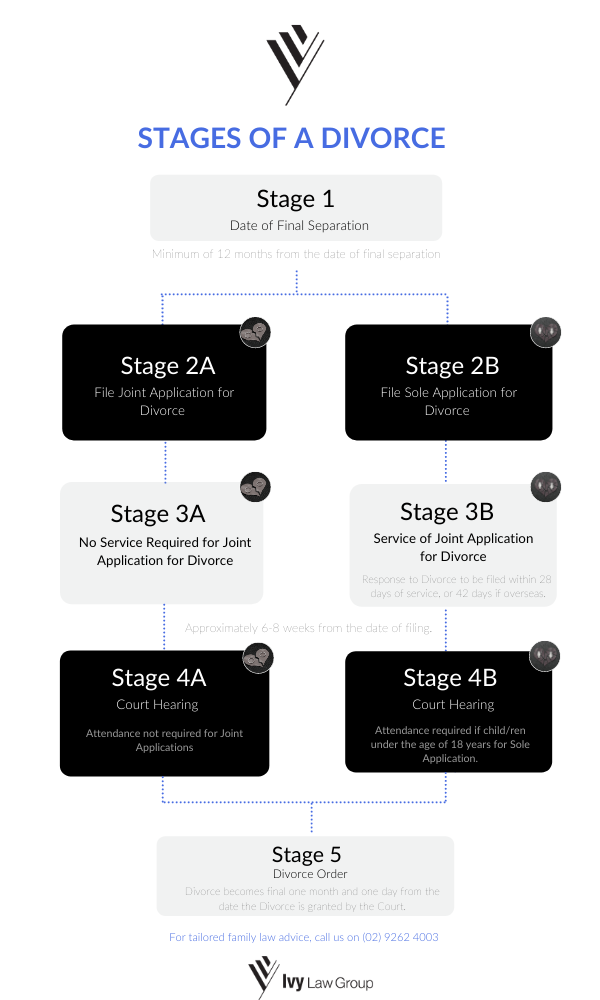Divorce Lawyers Sydney

Divorce in Australia
Divorce is the legal termination of a marriage. Because it’s a legal process, there are some hurdles you need to clear to be able to proceed with a divorce.
Our Sydney divorce lawyers have expertise across all areas of divorce, separation, child custody, child support, property and financial services.
We also approach our work with compassion and understanding – because we understand that for families, divorce is more than just the legal termination of marriage. Our team will help you end your marriage and move on with your life.
It is important to remember that if you are going through a divorce, you are not alone. Many marriages and relationships inevitably come to an end.
For advice about marriage breakdown, contact the family lawyers at Ivy Law Group on (02) 9262 4003 or submit an online enquiry to arrange a free, no-obligation initial consultation.
“No fault” divorce system
The Family Law Act 1975 introduced a no fault divorce system. This means you no longer need to provide evidence of an affair, drunkenness, insanity or the like when applying for a divorce in Australia.
You do, however, need to show that the marriage has broken down irretrievably and there is no reasonable likelihood of reconciliation.
Even though Australia has a no fault divorce system, and the reasons for your marriage coming to a legal end are not relevant, there may be some factors that the Court will still consider when considering other applications that follow the end of a marriage, such as when you are making interim or final parenting arrangements.
To give an example, if one party has a history of mental illness, drug or alcohol abuse or if there was domestic violence in the marriage, the Court will not take note of this for the purposes of the Divorce, but it could be relevant if a Court was considering an Application for Parenting Orders.
Can I apply for a divorce?
You can apply for a divorce on your own (a sole application) or jointly with your former spouse.
In Australia, you’re eligible to apply for a divorce if either you or your former spouse:
- regard Australia as your home and intend to live in Australia indefinitely; or
- are an Australian citizen by birth, descent or by grant of Australian citizenship; or
- ordinarily live in Australia and have done so for the 12 months immediately before filing for divorce.
Additionally, the Court must be satisfied that:
- you and your former spouse have lived separately and apart for at least 12 months; and
- that there is no prospect or reasonable likelihood of reconciliation.
It is possible for you and your former spouse to be separated under the same roof.
If you and your former spouse have reconciled briefly, you can still apply for a divorce if:
- the period of reconciliation was no longer than three months; and
- the period of separation prior to and after the brief reconciliation add up to at least 12 months.
Once your Divorce Order becomes final, you still have to deal with the issues of property distribution, financial support (either spousal maintenance or child support) or arrangements for the children. The Divorce Order simply confirms the marriage has ended.
Same-sex divorces in Australia
Same-sex couples, whose marriages are recognised under the Family Law Act 1975, can apply for a divorce and with the same requirements as in heterosexual divorce, regardless of when the marriage took place.
Same-sex marriages are recognised retrospectively from 7 December 2017, which is the date same-sex marriage became recognised in Australia. Therefore, if you and your former spouse separated prior to this date the 12-month separation period is still required.
Divorce applications: How do I apply for a divorce in Australia?
The Divorce Process

How to get a divorce in Australia
STAGE 1: Date of final separation
There is only one ground for divorce – the irretrievable breakdown of your marriage.
This ground is satisfied if you and your former spouse separate and live apart for at least 12 months. At the date of separation, at least one of you must have intended that the marriage was over.
If you’ve been married for less than two years, you’ll also have to participate in counselling to discuss the possibility of reconciliation before making the divorce application. Then, when you are filing your application for divorce you also need to file a Counselling Certificate with the Court.
STAGE 2: Filing an Application for Divorce
The Federal Circuit and Family Court of Australia has the power to deal with Divorce Applications under Part VI of the Family Law Act 1975.
Once the 12-month separation period has passed, either you, your former spouse, or both of you together, will need to file the following documents in the Federal Circuit and Family Court of Australia:
- Divorce Application Form;
- Marriage Certificate, and if it is not in English, a translation by a certified translator;
- Proof of jurisdiction – eg: Australian citizenship certificate, Australian passport or visa;
- Counselling certificate if marriage less than 2 years; and
- An Affidavit if you have been separated under one roof;
Applications need to be filed, and sealed orders obtained from the Commonwealth Court’s Portal. This means that if you are filing a Divorce Application yourself, you will need to register for the Commonwealth Courts Portal.
The filing of a Divorce Application, incurs a filing fee, which for the 2023 FYE is $1060. If you have a concession card this may reduce the filing fee payable to $350.
Once the application is filed, you will be given a date for the hearing of your application. Depending on whether the application was jointly or solely filed, and whether there are children of the relationship, will impact on whether there is a need for you to attend in Court for the hearing of your Application.
STAGE 3: Service
Service is the legal term given to delivering Court documents to another person to satisfy the Court’s process and ensure the person being served has received the documents. When serving documents relating to an Application for Divorce, you are required to provide your spouse with the following:
- the Application for divorce
- Marriage, Families and Separation brochure
- a blank Acknowledgment of service form
- the Affidavit for eFiling signed by your spouse, and
- any other documents filed by you at the time of the Application for divorce including the Marriage Certificate, and any affidavit in support.
If you make an Application for Divorce, then service is required on the other party (known as the Respondent). Service does not have to be completed if a joint application for divorce has been made.
You should note that the Applicant cannot serve the Respondent personally. If you are the applicant and you are not legally represented (allowing your legal representative to attend to service for you), you will need to arrange for a process server or an adult over the age of 18 to attend to service on your behalf.
Service is proved by completing and filing the following forms:
- an Acknowledgement of Service form that is provided to the Respondent for their signature.
- An Affidavit of Service (signed by the person who served the documents) and usually annexing the returned Acknowledgement of service.
- Affidavit Proving Signature in circumstances where the Divorce Application is served by hand.
These documents must also be filed with the Court via the Commonwealth Courts Portal.
Documents can be served by:
- Hand
A process server, who is hired for a fixed fee, or any person over the age of 18 years can hand deliver the documents on your behalf to your former spouse.
- Post or electronic communication (for example, facsimile or email).
This service can be used when you are aware of your former spouse’s residential address and are certain they will sign the Acknowledgment of Service form and return the original to you for filing.
- Service on a lawyer
If your former spouse is represented by a lawyer, and the lawyer agrees in writing to accept service, then the documents can be served on the lawyer’s office.
Service within Australia must occur at least 28 days before the hearing date of the Divorce Application. If your spouse is overseas, then service must occur at least 42 days before the hearing.
If the Court is satisfied that service has been completed, then the person served will not need to be present at a Court hearing for Orders to be made.
If the Respondent considers that the Divorce Application has errors of fact they can choose to file a Response to Divorce.
If the Respondent does not agree to the Divorce Application or a Divorce Order being grantedthen they may also file a Response to Divorce and must appear at the hearing.
A respondent can only oppose a divorce application in the following circumstances:
- there has not been 12 months separation as alleged in the application; or
- the Respondent alleges that the Court does not have jurisdiction to grant the divorce.
The Response is required to be filed within 28 days of service if the Respondent is in Australia, or within 42 days of service if the Respondent is overseas. The Respondent will then need to serve the Response to Divorce on the Applicant.
STAGE 4: Court hearing
Once you file the Application for Divorce, you will be provided with a date for a Judicial Registrar to hear your matter. The date of hearing is approximately six to eight weeks from the date of filing and will occur electronically. Parties will be provided the dial-in details for the hearing a couple of days before the hearing occurs.
Whether you will be required to attend the hearing depends on the circumstances.
You must attend at your hearing if you have submitted a Sole Application and:
- There are children under 18 years;
- You file an application for substituted service or dispensation of service;
- A Response to Divorce has been filed.
You are not required to attend if you have filed a Joint Application for Divorce.
If you are unable to attend the hearing, your solicitor/family lawyer may attend on your behalf.
STAGE 5: Divorce Order
If the Registrar is satisfied that there has been a separation of at least 12 months, and all other legislative requirements are met, the Divorce Order dissolving your marriage will be made.
The Divorce Order will become final one month and one day after it is made, and you are then free to remarry should you wish to do so.
A copy of the Divorce Order will become available at this time via the Court’s portal which you (or your solicitor if you are represented) can access. Hard copies of the Divorce Order are no longer issued by the Court.
If you require legal advice about your specific circumstances, our Sydney divorce lawyers are here to assist. Get in touch with us on 02 9262 4003 or submit an online enquiry.
Important time limitations for divorce (married couples only)
Application for Divorce
Service of Application for Divorce and accompanying material | 12 months from the date of separation (married couples only).
28 days before the hearing if the Respondent is in Australia or 42 days before the hearing if the Respondent is overseas. |
Divorce Order | Becomes final one month and one day after the Court grants Divorce at the Court hearing. |
Response to Divorce (Australia) | Response must be filed within 28 days from the date of service. |
Response to Divorce (overseas) | Application must be filed within 42 days from the date of service. |
Special Service | As soon as practicable, but no longer than 12 months from the date of filing. |
Application for Property Settlement | Within 12 months from the date upon which your divorce becomes final. |
Application for Spousal Maintenance | Within 12 months from the date upon which your divorce becomes final. |
Parenting Matters | Proceedings can be commenced at any time. If final orders have been made in parenting matters, then proceedings can only be recommenced if there is a significant change in the circumstances. |
Application for Leave | If you fail to commence proceedings within the time limitations, then you must apply to the Court for permission to commence proceedings out of time. To do so, you will have to provide an explanation to the Court about why you failed to commence the proceedings within the required time and show that the failure of the Court to make an Order would cause you hardship. |
How do I apply for a divorce if I was married overseas?
The same process applies for a Divorce Application if you were married overseas, provided you or your former spouse:
- regard Australia as your home and intend to live in Australia indefinitely, or
- are an Australian citizen by birth, descent or by grant of Australian citizenship, or
- ordinarily live in Australia and have done so for the 12 months immediately before filing for divorce.
You must provide a copy of your marriage certificate to the Court with your divorce application. If it is not in English, you will need to file an English translation of the marriage certificate and an Affidavit of the Translator annexing the translation.
Can I divorce in another country?
If you and your former spouse have been granted a Divorce Order overseas, then it will be recognised in Australia provided it was made in accordance with the local laws of the country where the divorce was issued.
You do not need to register your divorce in Australia.
Annulment of marriage
What is an annulment of marriage or nullity of marriage?
When a marriage is annulled, it means there was no legal marriage.
An annulment of marriage in Australia requires a decree of nullity. This decree is an Order which confirms that no legal marriage occurred between the parties, regardless if there was a marriage ceremony.
The Family Court of Australia may declare that there was no legal marriage if one of the following grounds is met:
- one or both of the parties was married at the time the marriage took place
- one or both parties were under the legal age of marriage (18 years) and did not have the necessary consent to marry
- one or both parties were forced into the marriage under duress
- the parties are in a prohibited relationship
- either party did not provide consent to the marriage because:
– consent was obtained by fraud or duress
– one party to the marriage was mistaken by identify of who they were marrying or the nature of the ceremony
– one party was mentally incapable of understanding the nature and the effect of the marriage ceremony.
How to apply for a marriage annulment
To have your marriage annulled, you need to apply for a decree of nullity. You do this by filing the following documents with the Federal Circuit and Family Court of Australia:
- an Initiating Application (Family Law) form
- an Affidavit setting out the facts you will rely on to have the marriage annulled, including the relevant details about the type of marriage ceremony performed
- a copy of the marriage certificate, unless you have already provided a copy to the Court.
You’ll also need to pay an application fee of $1,335. If you have a Concession Card this may reduce the filing fee payable to $445.
Serving an Application for Decree of Nullity
The person making the application, known as the Applicant, must provide to the Respondent and all relevant parties:
- a copy of the filed Application for Decree of Nullity;
- any Affidavit that is filed in support of the Application for Decree of Nullity;
- acknowledgement of Service Form; and
- the Marriage Families and Separation Brochure.
To prove service, you must file an Acknowledgment of Service with an Affidavit of Service from the person who served the documents on the other side. This can be filed via the Court portal.
What happens next?
The Respondent can file a Response to Initiating Application if:
- consenting to or opposing any of the orders sought in the Initiating Application; or
- seeking any other orders in accordance with Part 2.4 of the Family Law Rules.
The Respondent will also need to file an Affidavit in support of their Response to the Initiating Application. The Respondent and Affidavit must be filed and served within 28 days of service of the Initiating Application.
If the Respondent does not wish to contest any of the Orders sought in the Initiating Application and will submit to any order made by the Court in relation to the Application, a submitting Notice should to be filed.
Is an attendance at the Hearing for Decree of Nullity necessary?
The Applicant and the Respondent must both attend the first Court event.
Time Limitations for Nullity Proceedings
Applications for a decree of nullity do not require a 12 month separation period.
Unlike a divorce, a decree for nullity comes into effect immediately.
Get in touch with our Sydney Divorce Lawyers
Frequently asked questions about divorce
No, you’ll need to wait a little longer.
If you wish to remarry, you can do so from the date that the Divorce Order becomes final. That’s one month and one day from the date the Court grants the Divorce Order.
For more information about timing, please see Important Time Limitations for Divorce.
Yes, but you can only oppose a divorce application where:
- the Court does not have jurisdiction to grant the divorce, or
- the Application for Divorce alleges that 12 months of separation has occurred, but it has not.
If you do not want the Divorce Order to be granted, you must file a Response to Divorce Application and attend at the hearing.
It depends.
If there are no children under the age of 18 years, you do not have to attend the Court hearing. This applies for both joint and sole applications for divorce.
You don’t need to attend for a joint application, even if you have children under the age of 18 years.
If you’re a sole applicant and have at least one child under the age of 18 years, you will be required to attend the hearing unless circumstances arise which mean you are unable to attend. If you are unable to attend, you can have your solicitor attend on your behalf.
Divorce papers generally means the Divorce Order granted by the Federal Circuit and Family Court of Australia.
If you or your former spouse file an Application for Divorce with the Federal Circuit Court of Australia, that application will be heard approximately six to eight weeks after it is filed.
At the Court hearing, if the Registrar grants a Divorce Order, then it will become final one month and one day from the date of the Court hearing. At this time, your divorce becomes final and your marriage is officially over.
For further information, please see Important Time Limitations for a Divorce.
Yes. A family lawyer specialises in family law matters and can act on your behalf in relation to:
- divorce
- parenting matters
- financial matters (including but not limited to property and spousal maintenance matters)
- child support matters
- mediation, negotiations, arbitrations and conciliation conferences
- any other matter with proceedings held in the Federal Circuit and Family Court of Australia, or in alternative dispute resolution forums.
In Australian law, we use the term divorce to describe a dissolution of marriage.
You can complete the Divorce Application form via the Commonwealth Courts Portal.
To find out how to apply for a divorce in NSW, our Sydney divorce lawyers have provided a step-by-step breakdown of the process here: Divorce application: How do I apply for a divorce in Australia?





